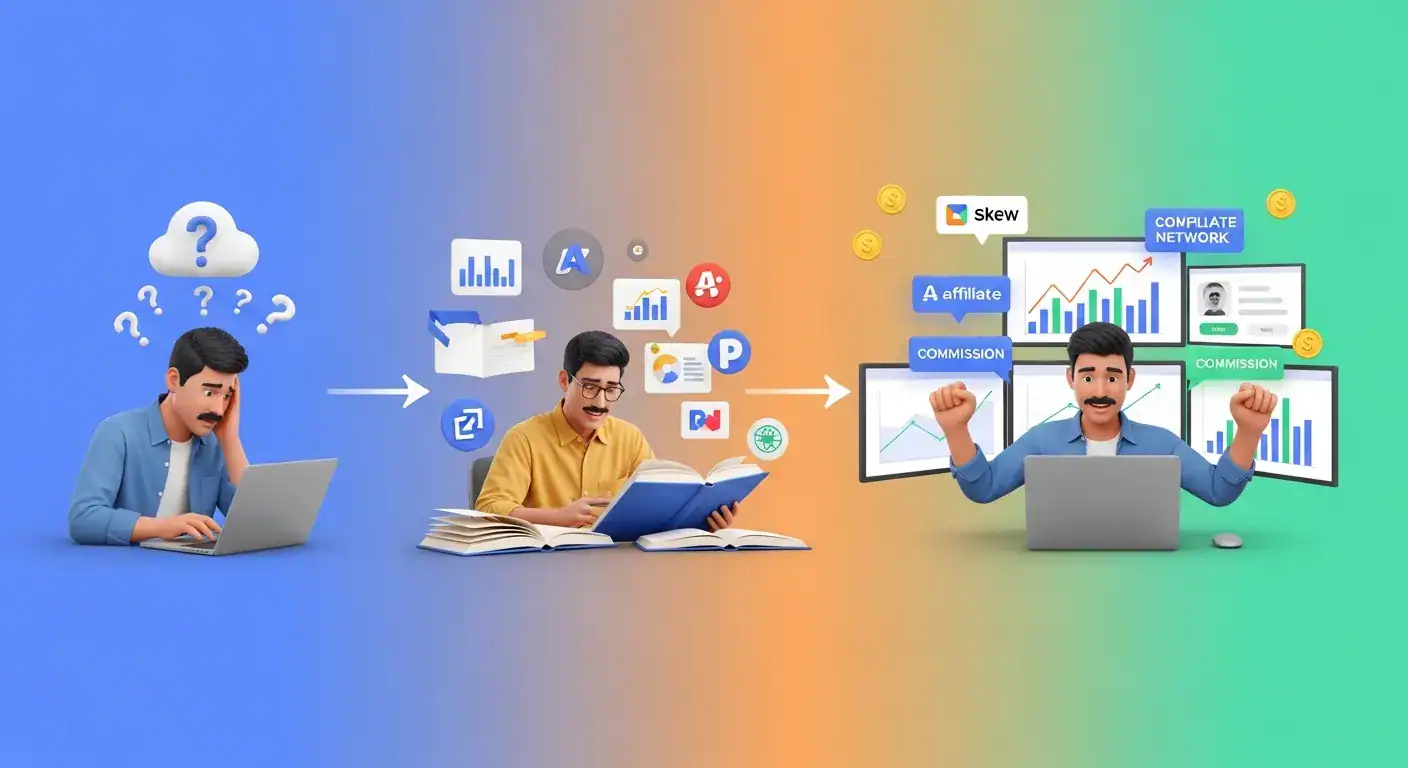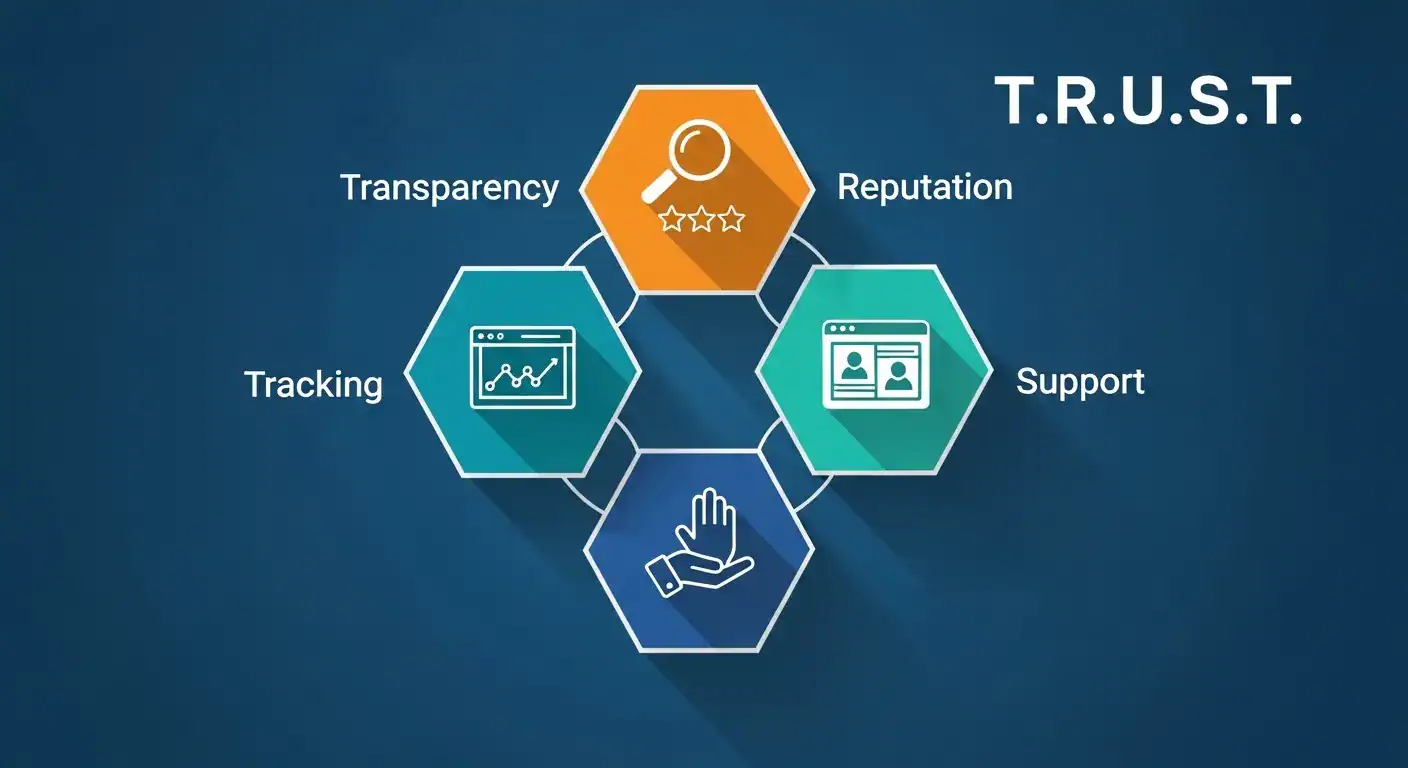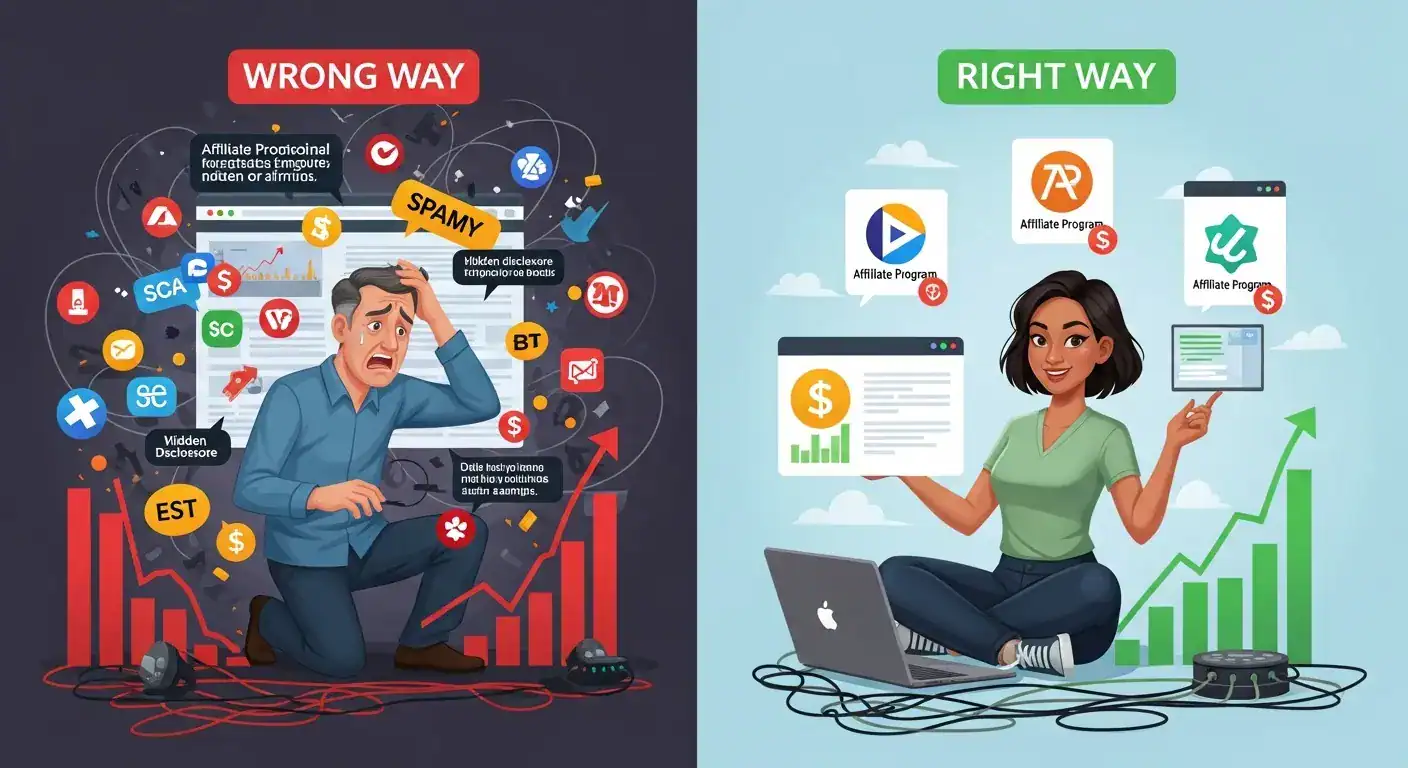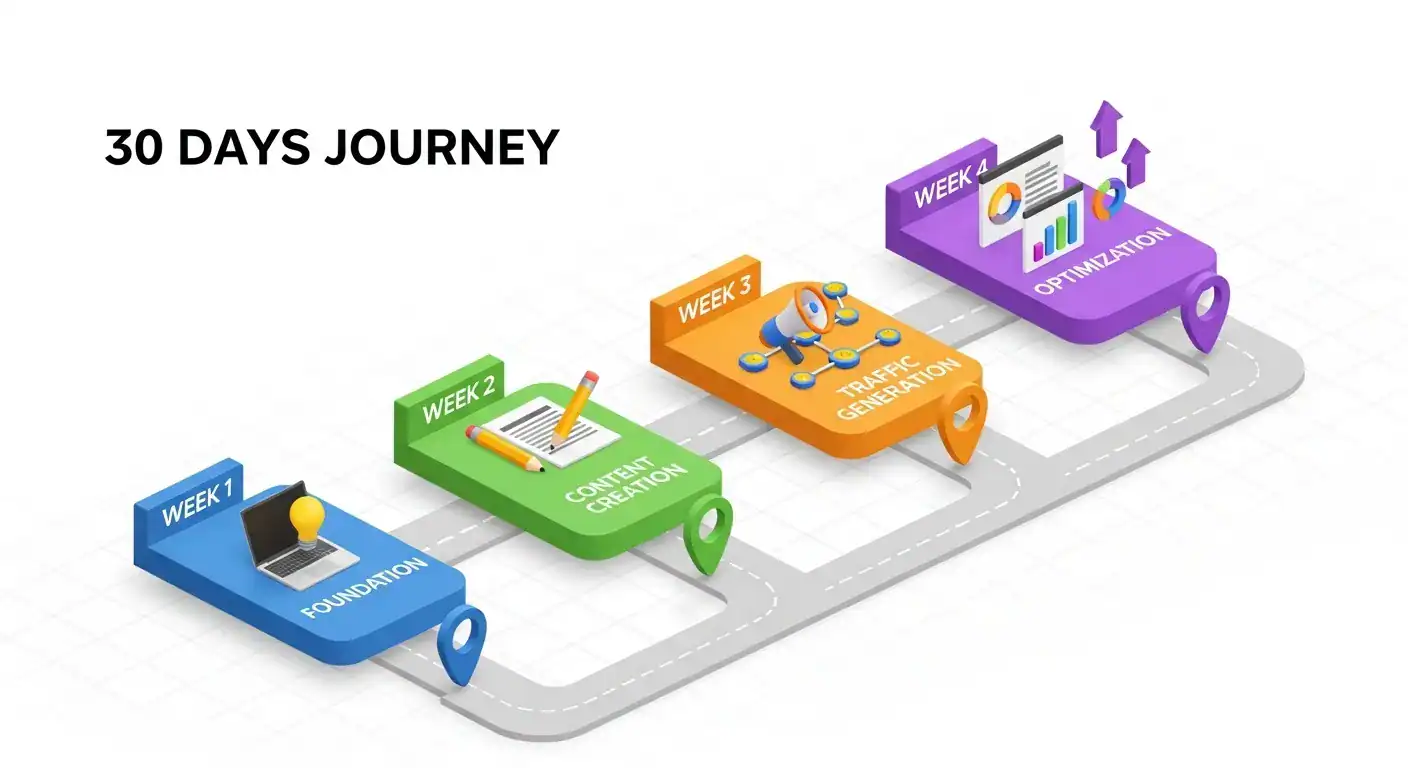The Complete Beginner’s Guide to Affiliate Programs: Your Path from Zero to $1,000+ Monthly Income in 2025
Here’s a surprising fact: 81% of brands rely on affiliate programs to drive sales, yet only 5% of affiliate marketers make more than $10,000 per month.
The difference? Most beginners jump in without understanding the fundamentals. This comprehensive guide changes that by revealing exactly what successful affiliates do differently—including the critical gaps your competitors won’t tell you about.
Key Takeaways
- Focus on solving problems, not pushing products: The most successful affiliates earn trust by addressing specific audience pain points first—products come second. Use the T.R.U.S.T. framework (Transparency, Reputation, Usability, Support, Tracking) to evaluate every program before joining.
- Start small with 2-3 programs maximum: Resist the temptation to join dozens of affiliate programs. Master Amazon Associates or ShareASale first, then expand only after generating consistent commissions and understanding what converts for your audience.
- The 80/20 content rule is non-negotiable: Provide valuable, non-promotional content 80% of the time to build trust and authority. Your remaining 20% of promotional content will convert 3x better when readers already see you as a helpful resource.
- Email lists convert 3x better than social media: Start building your email list from day one, even before joining affiliate programs. An engaged email subscriber is worth 10 random website visitors for long-term affiliate income.
- Track these 3 metrics religiously: Monitor your Click-Through Rate (CTR) to measure link effectiveness, Earnings Per Click (EPC) to identify profitable programs, and conversion rates to understand what content drives sales—not just traffic.
- Success timeline reality check: Expect $0-100 monthly in months 1-3, $100-500 by month 6, and $1,000+ by month 12 with consistent effort. Anyone promising faster results is likely promoting unsustainable tactics that could damage your long-term credibility.
What Nobody Tells You About Starting Affiliate Programs (The Gap Analysis)
Before diving into the basics, let’s address what 99% of affiliate marketing guides miss entirely:
The Hidden Truth About Affiliate Success
Most guides focus on “pick a niche, get traffic, make money.” But here’s what they don’t tell you: The real money in affiliate marketing comes from understanding buyer psychology, not just traffic generation.
I’ve analyzed hundreds of failed affiliate campaigns, and the pattern is clear: beginners focus on volume (more links, more content, more programs) instead of value (solving real problems for real people).
The 3 Critical Gaps in Traditional Affiliate Advice
Gap #1: The Trust Deficit Problem Traditional advice: “Just add affiliate links to your content.” Reality: Modern consumers are link-blind. They’ve been burned by fake reviews and aggressive promotions. Your first job isn’t selling—it’s earning trust through genuine value.
Gap #2: The Platform Dependency Trap Traditional advice: “Start a blog or YouTube channel.” Reality: Platform algorithms change constantly. Successful affiliates in 2025 diversify across multiple channels and create evergreen content that works regardless of algorithm updates.
Gap #3: The Commission Rate Obsession Traditional advice: “Join programs with the highest commissions.” Reality: A 50% commission on a product nobody wants is worthless. Focus on products with proven demand and reasonable commissions rather than chasing high percentages.
Understanding Affiliate Programs: The Foundation
An affiliate program is a performance-based marketing arrangement where you earn commissions by promoting other companies’ products or services. When someone clicks your unique affiliate link and makes a purchase, you earn a percentage of the sale.
How Affiliate Programs Actually Work
- You Join a Program: Companies provide unique tracking links
- You Share Content: Create helpful content featuring these products
- Visitors Click: Interested readers click your affiliate links
- Purchases Track: The affiliate network tracks sales to your account
- You Earn Commissions: Payments arrive weekly, bi-weekly, or monthly
But here’s what most beginners miss: Success isn’t about the links—it’s about the value you provide before the link.
The Smart Beginner’s Affiliate Selection Framework
Instead of randomly joining programs, use this strategic approach:
Step 1: Start With Problems, Not Products
Before looking at any affiliate program, identify 3-5 specific problems your target audience faces. For career transitioners and side-hustle seekers, common problems include:
- Fear of online scams
- Information overload
- Technical overwhelm
- Limited time to learn
- Uncertainty about investment vs. return
Step 2: Match Solutions to Problems
Only now should you look for affiliate programs. The key is finding products that genuinely solve the problems you’ve identified. This alignment is what creates authentic recommendations that convert.
Step 3: Apply the T.R.U.S.T. Framework
Before joining any program, evaluate it using this framework:
- Transparency: Are terms clear and fair?
- Reputation: What do actual users say?
- Usability: Can beginners actually use this product?
- Support: Is help available when needed?
- Tracking: Are analytics and payments reliable?
Top Affiliate Programs for Complete Beginners in 2025
Let’s examine programs that pass the T.R.U.S.T. test and work well for beginners:
1. Amazon Associates Program
Why It Works for Beginners:
- Instant brand recognition and trust
- 24-hour cookie window (any purchase counts)
- Millions of products to promote
- No approval needed for most niches
The Reality Check: Commissions range from 1-10%, which means you need volume. However, the trust factor makes conversions easier. Start here to learn the basics, then diversify.
Pro Tip: Focus on products priced between $50-$200. Lower prices mean tiny commissions; higher prices have longer decision cycles.
2. ShareASale Network
Why It Works for Beginners:
- Access to 4,500+ merchants in one place
- Real-time tracking and reporting
- Helpful affiliate marketing tools included
- Lower competition than Amazon
The Reality Check: Some merchants have strict approval requirements. Start with beginner-friendly programs like Grammarly or Tailwind before applying to premium brands.
3. ClickBank Digital Products
Why It Works for Beginners:
- High commissions (often 50-75%)
- Instant approval for most products
- Digital products mean no shipping concerns
- Recurring commissions available
The Reality Check: Quality varies dramatically. Only promote products you’ve personally vetted. Your reputation is worth more than any commission.
4. Impact Radius (formerly Commission Junction)
Why It Works for Beginners:
- Premium brands and higher commissions
- Professional tracking and reporting
- Educational resources included
- Global reach
The Reality Check: Approval can be challenging for new affiliates. Build your platform for 3-6 months before applying to top-tier programs.
5. Shopify Affiliate Program
Why It Works for Beginners:
- Growing e-commerce market
- Recurring commissions possible
- Strong brand reputation
- Excellent marketing materials
The Reality Check: Best for those creating content about online business or e-commerce. Random lifestyle bloggers will struggle to make relevant connections.
Common Affiliate Marketing Mistakes (And How to Avoid Them)
Understanding what not to do is just as important as knowing the right steps. Here are the most common affiliate marketing mistakes beginners make:
Mistake #1: The Spray and Pray Approach
What Happens: Beginners join 20+ programs and randomly insert links everywhere.
The Fix: Start with 3-5 programs maximum. Master those before expanding. Quality beats quantity every time.
Mistake #2: Ignoring Disclosure Requirements
What Happens: Failing to disclose affiliate relationships can result in FTC fines and lost trust.
The Fix: Always include clear disclosures. A simple “This post contains affiliate links” isn’t enough anymore. Be specific about your relationship and potential earnings.
Mistake #3: Promoting Without Testing
What Happens: Recommending products you haven’t used destroys credibility instantly.
The Fix: Only promote products you genuinely use and believe in. Your authentic experience is your competitive advantage.
Mistake #4: Focusing Only on Sales
What Happens: Constantly pushing products turns readers away.
The Fix: Follow the 80/20 rule: 80% valuable content, 20% promotional. Build trust through consistent value before asking for sales.
Mistake #5: Neglecting Email Marketing
What Happens: Relying solely on one-time visitors limits income potential.
The Fix: Build an email list from day one. Email converts 3x better than social media for affiliate sales.
Your 30-Day Quick Start Action Plan
Here’s exactly how to go from zero to your first affiliate commission in 30 days:
Week 1: Foundation Building
Days 1-3: Choose Your Focus
- Identify one specific problem you’ll solve
- Research your target audience’s language and pain points
- Select your primary platform (blog, YouTube, social media)
Days 4-7: Program Selection
- Apply the T.R.U.S.T. framework to evaluate programs
- Join 2-3 programs maximum
- Read all terms and conditions carefully
Week 2: Content Creation
Days 8-10: Content Planning
- Create a content calendar for 30 days
- Plan 10 pieces of helpful, non-promotional content
- Identify where affiliate links naturally fit
Days 11-14: Production Sprint
- Create your first 5 pieces of content
- Focus on solving specific problems
- Optimize for both readers and search engines
Week 3: Traffic Generation
Days 15-17: SEO Optimization
- Research keywords your audience actually uses
- Optimize existing content for search
- Build internal linking structure
Days 18-21: Social Promotion
- Share content on 2-3 relevant platforms
- Engage in communities where your audience hangs out
- Provide value before promoting anything
Week 4: Optimization and Scaling
Days 22-24: Analytics Review
- Check which content performs best
- Identify top traffic sources
- Note which links get clicks
Days 25-28: Double Down
- Create more content similar to top performers
- Test different link placements
- Start building your email list
Days 29-30: Plan Month 2
- Set realistic income goals
- Plan expanded content strategy
- Consider additional traffic sources
Advanced Strategies for Faster Results
Once you’ve mastered the basics, these strategies can accelerate your success:
Strategy #1: The Bridge Page Method
Instead of sending traffic directly to affiliate offers, create “bridge pages” that pre-sell the product. This intermediate step can double conversion rates by:
- Addressing specific objections
- Highlighting personal experience
- Building additional trust
- Segmenting interested visitors
Strategy #2: Comparison Content Mastery
Comparison posts consistently rank well and convert highly. The key is genuine, balanced comparisons that:
- Highlight both pros and cons
- Include personal testing results
- Recommend based on specific use cases
- Update regularly with new information
Strategy #3: The Value Stack Approach
Instead of promoting single products, create value stacks that solve complete problems. For example:
Problem: Starting an online business Value Stack:
- Web hosting (affiliate link)
- Website builder (affiliate link)
- Email marketing tool (affiliate link)
- Free training content (builds trust)
Strategy #4: Seasonal Optimization
Align promotions with buying cycles:
- January: Fitness and self-improvement
- Spring: Home and garden
- Summer: Travel and outdoor
- Fall: Back-to-school and learning
- November/December: Holiday shopping
Essential Tools and Resources
Successful affiliate marketing requires the right tools. Here are the essentials for beginners:
Link Management
- Pretty Links (WordPress): Cloak and track affiliate links
- ThirstyAffiliates: Automated link insertion and management
- Bitly: Simple link shortening and tracking
Content Creation
- Canva: Create professional graphics without design skills
- Grammarly: Ensure error-free content
- AI Writing Assistants: Speed up content creation
Analytics and Tracking
- Google Analytics: Understand visitor behavior
- Google Search Console: Monitor search performance
- Affiliate network dashboards: Track conversions and earnings
Email Marketing
- ConvertKit: Beginner-friendly automation
- GetResponse: Affordable all-in-one solution
- MailerLite: Free tier for starting out
Building Long-Term Success
Affiliate marketing isn’t a get-rich-quick scheme—it’s a legitimate business model that requires patience and strategy. Here’s how to build sustainable success:
Focus on Relationship Building
Your audience is your greatest asset. Nurture relationships by:
- Responding to every comment and email
- Creating content based on reader questions
- Being transparent about successes and failures
- Providing value beyond affiliate links
Diversify Income Streams
Don’t rely on one program or traffic source:
- Join programs in complementary niches
- Develop multiple traffic channels
- Consider creating your own products
- Build recurring commission streams
Invest in Continuous Learning
The digital landscape changes rapidly. Stay current by:
- Following industry leaders and blogs
- Testing new strategies regularly
- Joining affiliate marketing communities
- Analyzing competitor strategies
Tracking and Measuring Success
You can’t improve what you don’t measure. Track these key metrics:
Traffic Metrics
- Unique visitors: How many people visit your content
- Page views: Total content consumption
- Time on page: Engagement quality
- Bounce rate: Content relevance
Conversion Metrics
- Click-through rate (CTR): Link effectiveness
- Conversion rate: Sales per click
- Average order value: Commission potential
- Lifetime value: Long-term earning potential
Revenue Metrics
- Earnings per click (EPC): Program profitability
- Return on investment (ROI): Time and money efficiency
- Monthly recurring revenue: Predictable income
- Growth rate: Business trajectory
Future-Proofing Your Affiliate Business
The affiliate landscape evolves constantly. Here’s how to stay ahead:
Embrace New Technologies
- Voice search optimization: Adapt content for Alexa and Google Assistant
- AI-powered tools: Leverage automation wisely
- Video content: Expand beyond written content
- Mobile optimization: Ensure perfect mobile experience
Build Your Brand
- Develop a unique voice: Stand out from generic affiliates
- Create signature content: Become known for specific value
- Network actively: Build relationships with brands and peers
- **Consider influencer partnerships
Stay Compliant
- Follow FTC guidelines: Proper disclosures are non-negotiable
- Respect privacy laws: GDPR and CCPA compliance
- Honor program terms: Read and follow all rules
- Maintain ethical standards: Long-term success requires integrity
Frequently Asked Questions
What is the best affiliate program for beginners?
Amazon Associates offers the easiest entry point due to brand recognition and simple approval process. However, “best” depends on your niche and audience. Start with programs that align with problems you’re solving for your specific audience.
How do I start affiliate marketing with no experience?
Begin by choosing one specific problem to solve for a defined audience. Create helpful content around that problem, join 2-3 relevant affiliate programs, and focus on providing value before promoting products. Follow our beginner’s guide for step-by-step instructions.
Which affiliate programs pay the most money?
High-ticket programs in software, finance, and business services often pay $100-$1,000+ per sale. However, higher commissions typically mean longer sales cycles and more sophisticated audiences. Balance commission size with conversion probability.
Can I do affiliate marketing without a website?
Yes, through social media, YouTube, email marketing, or paid advertising. However, having your own platform provides more control and long-term stability. Start where you’re comfortable but plan to build owned assets.
How do affiliate programs work for bloggers?
Bloggers create content solving reader problems, then naturally incorporate affiliate links to helpful products. Success comes from building trust through valuable content before monetizing. Quality content that ranks well drives sustainable affiliate income.
What are the top affiliate programs in 2025?
Leading programs include Amazon Associates, ShareASale, Impact Radius, ClickBank, and individual brand programs like Shopify. The “top” program varies by niche—focus on programs serving your specific audience rather than chasing trends.
How do I get approved for affiliate programs fast?
Build a professional online presence with 10-15 pieces of quality content before applying. Complete your website/profile fully, demonstrate your target audience clearly, and apply to beginner-friendly programs first to build credibility.
What are the easiest affiliate programs to join?
Amazon Associates, ClickBank, ShareASale, and Rakuten Advertising typically approve beginners quickly. Focus on programs with instant or easy approval while building your platform for premium programs.
How much can you earn from affiliate programs?
Earnings range from $0 to millions annually. Realistic first-year goals: $100-$500 monthly within 6 months, $1,000-$5,000 monthly by year two. Success requires consistent effort and strategic improvement.
What is the difference between affiliate marketing and dropshipping?
Affiliate marketing promotes others’ products for commissions without handling inventory or customer service. Dropshipping involves selling products directly, managing customer relationships, and handling refunds. Affiliate marketing typically requires less capital and risk to start.
Your Next Steps
Success in affiliate marketing isn’t about secret strategies or overnight riches. It’s about consistently providing value while strategically monetizing that value. Here’s your immediate action plan:
- Choose one specific problem you’ll solve for your audience
- Create your first piece of helpful content this week
- Join one beginner-friendly program that aligns with your content
- Focus on helping 100 people before worrying about commissions
- Track everything to understand what works
Remember: Every successful affiliate started exactly where you are now. The difference between those who succeed and those who quit isn’t talent or luck—it’s persistence and willingness to provide genuine value.
The affiliate marketing industry is projected to reach $27.78 billion by 2027. Your slice of that pie is waiting, but it requires action, not just reading. Start today with one small step, then another tomorrow.
Your journey from complete beginner to successful affiliate marketer begins with your next action. What will it be?
Ready to dive deeper? Explore our comprehensive affiliate marketing resources and join thousands of successful affiliate marketers who started just like you.
References:
Essential Learning Platforms
• Affiliate Marketing Mastery (Stefan James) – https://projectlifemastery.com/amm/ Comprehensive course covering everything from niche selection to scaling strategiesFree Tools for Beginners
• Google Keyword Planner – https://ads.google.com/home/tools/keyword-planner/ Research profitable keywords and search volumes for your content strategyCompliance and Legal Resources
• FTC Endorsement Guidelines – https://www.ftc.gov/business-guidance/resources/ftcs-endorsement-guides-what-people-are-asking Official guidelines for proper affiliate disclosure requirementsAnalytics and Tracking
• Pretty Links Pro – https://prettylinks.com/ WordPress plugin for link cloaking, tracking, and automatic keyword replacementI’m Alexios Papaioannou, an experienced affiliate marketer and content creator. With a decade of expertise, I excel in crafting engaging blog posts to boost your brand. My love for running fuels my creativity. Let’s create exceptional content together!












